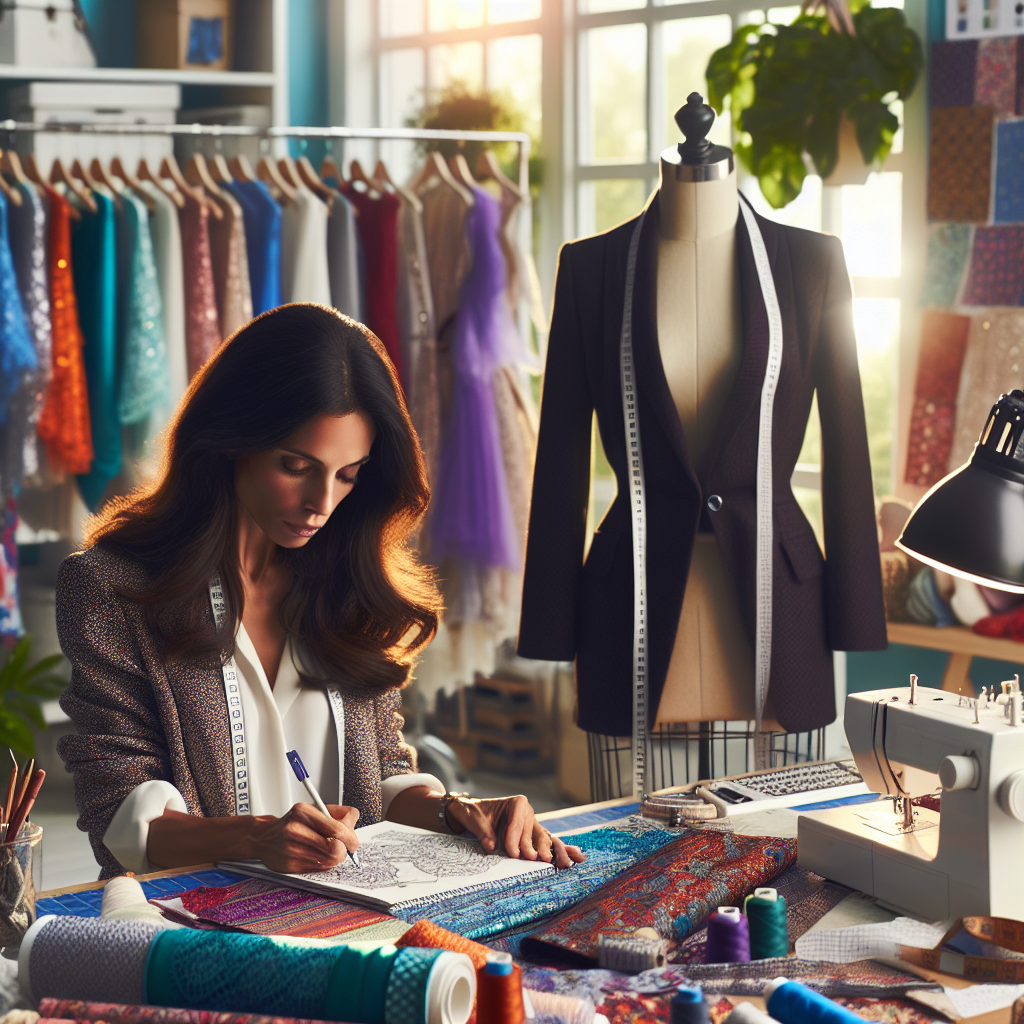
What Makes a Great Clothing Designer? Find Out Here!
Welcome to the fascinating world of clothing design! When it comes to what makes a great clothing designer, several key attributes distinguish the good from the truly exceptional. At the core, a great designer not only creates visually stunning pieces but also connects emotionally with their audience, making each garment a statement of personality and style.
A great clothing designer is often characterized by a unique blend of qualities. These include a boundless sense of creativity, an acute understanding of fashion trends, and a solid grasp of technical skills such as pattern-making and sewing. Moreover, they possess an innate ability to innovate while staying true to their brand's identity, ensuring that each collection tells a cohesive story.
In this article, we'll delve deeper into the various facets that contribute to the making of a great clothing designer. From creativity and technical expertise to understanding market trends and building a unique brand, we will explore it all. Whether you're an aspiring designer or simply curious about the fashion industry, this comprehensive guide will provide valuable insights into the art of clothing design.
Click on the product links to view the Dude's designs at thedudeabides.shop and get inspired by our unique blend of vintage and contemporary styles!
Understanding Essential Designer Skills

To excel in the world of fashion, a designer must master a variety of essential skills. These abilities form the backbone of their craft, enabling them to transform imaginative concepts into wearable art. Let's explore some of the core skills that define what makes a great clothing designer.
Technical Proficiency: A great designer must have a solid grasp of technical skills, including pattern drafting, sewing, and fabric manipulation. These skills are crucial for bringing a design from sketch to reality, ensuring that each piece is not only aesthetically pleasing but also functional and well-constructed.
Creativity and Innovation: At the heart of clothing design lies creativity. Great designers consistently push the boundaries of fashion by introducing fresh ideas and innovative designs. Their ability to think outside the box and draw inspiration from various sources helps them create unique pieces that stand out in a crowded market.
Trend Awareness: Keeping a pulse on current and upcoming fashion trends is essential for any designer. Understanding what is popular and anticipating future trends allows designers to create relevant and desirable collections that resonate with their target audience.
Attention to Detail: The difference between a good design and a great one often lies in the details. Designers must be meticulous in their work, paying close attention to every element, from stitching and fabric choice to embellishments and finishing touches. This attention to detail ensures a high-quality final product that reflects the designer's vision and craftsmanship.
Mastering these essential skills is a critical step on the path to becoming a great clothing designer. As we continue, we'll delve into the importance of creativity and how it sets exceptional designers apart from the rest.
Creativity and Innovation in Fashion

Creativity and innovation are the lifeblood of the fashion industry, distinguishing the truly great designers from the merely good. These elements not only fuel the creation of groundbreaking designs but also drive the evolution of fashion itself. So, what makes a clothing designer stand out in terms of creativity and innovation?
Originality: Great designers are known for their unique perspective and ability to bring fresh ideas to the table. They don't just follow trends; they set them. By blending different styles, experimenting with unconventional materials, and playing with textures and colors, they create pieces that are both distinctive and memorable.
Risk-Taking: Innovation often requires stepping out of one's comfort zone and taking risks. Designers who aren't afraid to challenge the status quo and push the boundaries of traditional fashion norms tend to make a lasting impact. Whether it's introducing a new silhouette or reimagining classic garments, their willingness to experiment sets them apart.
Inspiration: Creativity is often sparked by inspiration drawn from various sources such as art, culture, nature, and personal experiences. Great designers have an innate ability to absorb these influences and translate them into their work, creating designs that tell a story and evoke emotion.
Collaboration: Innovation in fashion is frequently the result of collaboration. Working with other creatives, such as artists, photographers, and even other designers, can lead to the fusion of ideas and the birth of groundbreaking concepts. These collaborative efforts often result in collections that are rich in creativity and innovation.
By embracing creativity and innovation, designers not only set themselves apart but also contribute to the dynamic and ever-changing landscape of fashion. As we move forward, let's explore the significance of understanding trends and how it influences a designer's success.
Technical Skills and Craftsmanship
While creativity and innovation are essential, they must be complemented by strong technical skills and exceptional craftsmanship to bring a designer's vision to life. Technical proficiency and a meticulous approach to craftsmanship are what transform an idea into a wearable masterpiece.
Pattern Making and Sewing: Understanding pattern making and sewing is fundamental for any clothing designer. These skills allow designers to translate their sketches into three-dimensional garments. Mastery of these techniques ensures that the final product not only looks great but also fits perfectly and feels comfortable.
Fabric Knowledge: A deep understanding of different fabrics and their properties is crucial. This includes knowing how fabrics drape, stretch, and behave when cut and sewn. Great designers can select the right material for their designs, enhancing both the aesthetics and functionality of the garment.
Attention to Detail: Exceptional craftsmanship is often evident in the details. Whether it's hand-stitched embellishments, precise seams, or perfectly aligned patterns, attention to detail can elevate a garment from ordinary to extraordinary. This meticulousness reflects a designer's dedication to quality and excellence.
Technical Drawing: Being able to create detailed technical drawings is another vital skill. These drawings serve as blueprints for the production process, ensuring that every aspect of the design is communicated clearly to those involved in manufacturing. Accurate technical drawings help maintain the integrity of the original design throughout the production stages.
Garment Construction: Knowledge of garment construction techniques is essential for creating durable and well-made clothing. This includes understanding different types of seams, stitches, and finishes. Skilled designers know how to construct garments that not only look good but also withstand the test of time.
Combining creativity with technical expertise allows designers to produce high-quality, innovative fashion. As we delve deeper, let's explore the significance of understanding trends and how this knowledge influences a designer's ability to stay relevant in a fast-paced industry.
Understanding Fashion Trends

In the dynamic world of fashion, staying ahead of trends is essential for any designer aiming to make a mark. Understanding fashion trends not only helps designers create relevant and appealing collections but also positions them as thought leaders in the industry.
Trend Analysis: A great clothing designer must be adept at conducting trend analysis. This involves researching and identifying emerging styles, colors, and patterns. By keeping a close eye on runway shows, fashion weeks, and industry publications, designers can anticipate what will be popular in the coming seasons.
Consumer Insights: Understanding the preferences and behaviors of target consumers is crucial. Designers need to pay attention to what their audience is wearing, buying, and aspiring to. This insight allows them to create collections that resonate with their customers, fostering loyalty and driving sales.
Historical Context: Fashion is cyclical, with many trends re-emerging over time. A well-versed designer has a deep appreciation for the history of fashion and can draw inspiration from past eras. This historical context allows them to reinvent classic styles with a modern twist, appealing to both nostalgic and contemporary tastes.
Cultural Influence: Culture plays a significant role in shaping fashion trends. Designers must stay attuned to cultural shifts, societal changes, and global events, as these factors often influence what people wear. By understanding the cultural zeitgeist, designers can create collections that are not only stylish but also culturally relevant.
Technology and Innovation: With the advent of new technologies and materials, fashion trends are constantly evolving. Designers who embrace innovation can set themselves apart by incorporating cutting-edge fabrics, sustainable practices, and tech-driven designs. This forward-thinking approach keeps their work fresh and exciting.
By mastering the art of trend analysis and staying connected to their audience, designers can create collections that are both current and timeless. As we move forward, let's explore how building a unique brand identity can further distinguish a designer in the crowded fashion landscape.
Building a Unique Brand Identity
In the fiercely competitive world of fashion, building a unique brand identity is paramount for a designer's success. A strong brand identity not only differentiates a designer from their peers but also creates a lasting impression on consumers, fostering loyalty and recognition.
Authenticity: At the core of any great brand is authenticity. Designers should stay true to their vision, values, and aesthetic. Authenticity resonates with consumers who appreciate genuine and heartfelt designs. It’s about creating pieces that reflect the designer’s unique perspective and story.
Consistent Visual Style: Consistency in visual elements such as logos, color schemes, and typography helps in creating a cohesive brand image. This visual consistency should be reflected across all platforms, from the website to social media and product packaging, ensuring that the brand is easily recognizable.
Narrative and Storytelling: Every brand has a story, and effective storytelling can significantly enhance a brand’s appeal. Designers should craft narratives around their collections, drawing inspiration from personal experiences, cultural elements, or historical references. These stories not only engage customers but also deepen their connection to the brand.
Customer Engagement: Engaging with customers and building a community around the brand is crucial. This can be achieved through social media interactions, email newsletters, and exclusive events. Encouraging user-generated content and feedback also helps in creating a sense of belonging and loyalty among customers.
Innovation and Adaptability: While maintaining a consistent brand identity is important, designers should also be open to innovation and change. The fashion industry is ever-evolving, and successful brands are those that can adapt to new trends and technologies while staying true to their core identity.
By focusing on authenticity, visual consistency, storytelling, customer engagement, and adaptability, designers can build a strong and unique brand identity that stands the test of time. Ready to see some designs that embody these principles? Click on the product links to view the Dude's designs.


